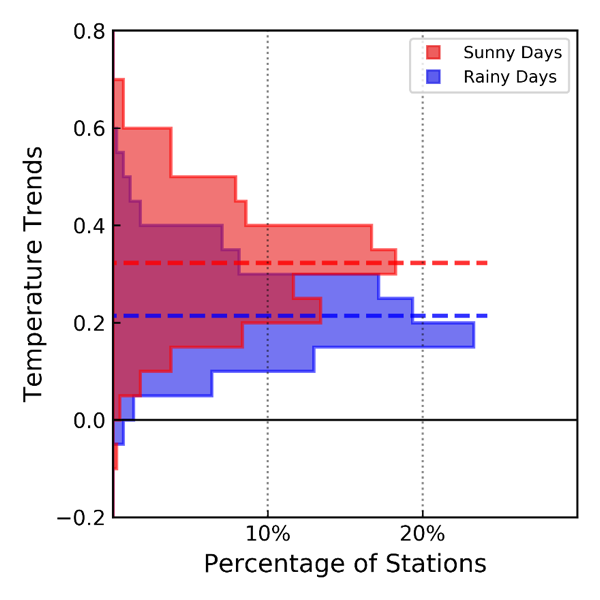Global warming, the increase in near-surface temperature due to the enhanced greenhouse effect at global scale, has clearly been reflected in observations over the last 50 years. However, the severities of warming in different regions and different period differs a lot. Scientists have considered many factors which may contribute to shape the temperature trends. For example, our ESD paper explained the stronger temperature trends over land compared to oceans by the different ways by which the diurnal variation in solar radiation is buffered on land and ocean. Here we introduce another simple but significant factor, sunny and rainy days.

Figure: Trends in daily mean temperature (in °C/10 years) on sunny and rainy days in observations from China.
Sunny and rainy days are two distinct types of days. On sunny days, which we classified with days without rain in this investigation, evapotranspiration removes water from the soil and adds it to the atmosphere, while the opposite takes place on rainy days. Temperatures are also different on sunny and rainy days. Generally, sunny days have higher daily maximum temperatures during daytime and lower daily minimum temperatures during nighttime, which results in a higher diurnal temperature range on sunny days compared to rainy days. However, these differences in temperature characteristics between sunny and rainy days are not shaped by evapotranspiration, but mainly caused by clouds. On the one hand, clouds block the sunlight so that less solar radiation arrives at surface on rainy days, resulting in a lower daily maximum temperature. On the other hand, clouds also prevent the energy escaping from the Earth (they cause a stronger greenhouse effect) resulting in higher minimum temperatures.
With these distinct differences, we investigated whether global warming behaves the same on rainy and sunny days using observations from meteorological stations in China. The result is surprisingly clear, with sunny days warmed much more strongly than rainy days (as shown in the Figure). We attribute this different speed of global warming on sunny and rainy days to the greenhouse effect of clouds and water vapor. On rainy days, there are more clouds and water vapor in the atmosphere, which makes the greenhouse effect almost saturated. Even though there are more greenhouse gases (e.g. CO2) in the atmosphere than 50 years ago, in this case the greenhouse effect cannot increase as much on rainy days. This is not the case on sunny days, where the greenhouse effect is naturally less intense, with less clouds and less water vapor. This leads to a stronger increase in the greenhouse effect and more pronounced temperature trends on sunny days.
This is not the end of the story. Given that arid regions typically have less rainy days, they are likely to have stronger temperature trends. This is consistent with previous studies that reported stronger temperature trends in regions with less precipitation (Portmann et al., 2009; Zhou et al., 2008). Moreover, it may have further implications for interpreting patterns of global warming on land and ocean. As land is typically drier than oceans, this may contribute to the higher climate sensitivity over land than oceans as well.
So far, what we did is mainly based on observations of precipitation and temperature. A next step to look further into this phenomenon would require a more detailed evaluation of the energy fluxes and the greenhouse effect on these contrasting types of days.
Muye Du
